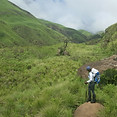Climbing Mount Elbrus: North versus South Route, East versus West Summit
- Tumi Mphahlele
- Jul 15, 2014
- 3 min read
Mount Elbrus is the tallest mountain in Russia, towering at 5,642 meters, it is not just the highest in Russia and in Europe, it is also one of the Seven Summits. There are different ways to climb Mount Elbrus - there is the standard South Route or the harder North route. Our choice was the North route, and looking back, it was seriously physically testing but, no regrets really, the experience was amazing.

My promise is this: As a Mount Elbrus climbers, you will witness a breathtaking panorama of the Caucasus Range with its great snow-capped peaks, lush valleys, and inspiring landscapes. The beauty of this region is really striking and the mountain ranges provide ample opportunities to soak in the natural wonders that surrounds it. You cannot help but feel privileged to climb this mountain and for witnessing the peaks with own eyes.
Getting to base camp
Reaching Mount Elbrus requires careful planning. The nearest major city to the mountain is Mineralnye Vody, which has an international airport, and so this makes it the most convenient gateway for climbers. We flew to MineralInye Vody from Moscow and ordinarily it is not a bad route. Climbers doing both the North and the South route get to the international airport at MinerlInye Vody.
From MineralInye Vody, the North base camp can be reached by road, a very interesting road trip I must add, especially the last hour of the drive.
Climbing Mount Elbrus from the North route requires fitness
It is important that those that plan to summit, especially on the North side, must have good cardiovascular fitness and have done sufficient strength training to take on the challenge. Like other climbs, proper acclimatization is also crucial to avoid altitude sickness, which can be a challenge due to the decreasing oxygen levels at higher elevations. The North route factors in sufficient time to acclimatize and this process takes several days and can be physically demanding too. Unlike the South Route, there are not snowcat or snow mobiles at any point of the climb.
For those intending to do more climbs, perhaps intending to do the rest of the seven summits or other high altitude climbs, the North route is recommended. On the North route, there is not much post postcards and t-shirts to purchase, but the experience is much more rewarding.
Mount Elbrus East versus West Summit
Mount Elbrus has two distinct summits: the East Summit and the West Summit. The difference between these two summits lies in their elevations. The East Summit stands as the true summit and reaches 5,642 meters above sea level, while the West Summit is slightly lower, at 5,621 meters. This height variation may seem slight, but it is actually significant. The routes to these summits differ significantly in terms of difficulty and approach. The East Summit requires more technical mountaineering skills, as it often involves traversing glaciers and steep terrain. The West Summit, on the other hand, is more accessible and favored by those seeking a less challenging ascent.
Climbers typically choose their summit based on their skill level and experience, with the East Summit offering a more demanding and rewarding climb, while the West Summit provides a relatively more straightforward route to the top.

Although the east peak is a recognised summit normally used when weather is bad, amongst climbers this is seen as a “no-summit”.
For Mount Elbrus, a North route and an East summit is first prize.


Comments